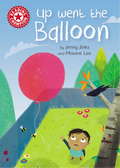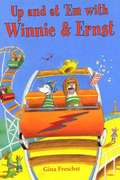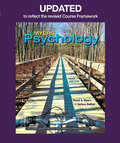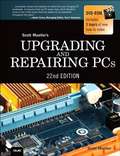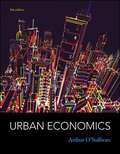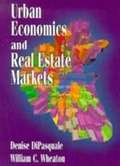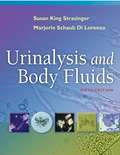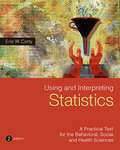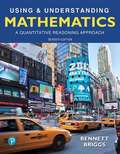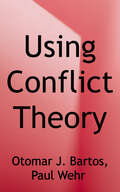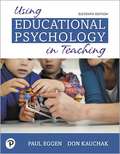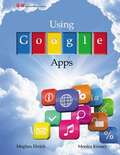- Table View
- List View
Up All Night (Fountas & Pinnell Classroom, Guided Reading Grade 3)
by Barbara Seuling Tracy SabinNIMAC-sourced textbook
Up Went the Balloon: Independent Reading Red 2 (Reading Champion #379)
by Jenny JinksThis story is part of Reading Champion, a series carefully linked to book bands to encourage independent reading skills, developed with Dr Sue Bodman and Glen Franklin of UCL Institute of Education (IOE)Dev's balloon is off on a grand adventure! Where will the balloon end up? With a bird? Up in the clouds? Read to find out!Reading Champion offers independent reading books for children to practise and reinforce their developing reading skills.Fantastic, original stories are accompanied by engaging artwork and a reading activity. Each book has been carefully graded so that it can be matched to a child's reading ability, encouraging reading for pleasure.
Up a Tree with a Koala (Fountas & Pinnell Classroom, Guided Reading Grade 3)
by Devra SperegenNIMAC-sourced textbook
Up and Down (Fountas & Pinnell Classroom, Guided Reading Kindergarten)
by Jacqueline Rogers Iris BarnesNIMAC-sourced textbook
Up and at 'Em with Winnie & Ernst
by Gina FreschetWinnie the possum and Ernst the otter are back with four new antic tales. In the first, an excursion to Backwater Beach is complicated by the contents of a piggy bank. Then Winnie gets a telescope and must ad-lib, as the viewing for her friends is disrupted by cloud cover. When Winnie and Ernst baby-sit for Mrs. H. Penny, they aren't prepared for her eggs to hatch. And finally, what better diversion for a February than to organize a poetry contest - but who knew what chaos such an event could cause?Children ready for a step up from early Beginning Readers will find plenty more to enjoy in these new stories.
Up in Flames (Fountas & Pinnell Classroom, Guided Reading)
by Fabio Leone Susan LayneNIMAC-sourced textbook
Upbhokra Arthashastra Six Semester TYBA New NEP Syllabus - RTMNU: उपभोक्ता अर्थशास्त्र सहावे सत्र टी.वाय.बी.ए. नवीन एन.इ.पी. अभ्यासक्रम - राष्ट्रसंत तुकडोजी महाराज नागपूर विद्यापीठ
by Dr Ashish Tembekar‘उपभोक्ता अर्थशास्त्र’ हे पुस्तक बी.ए. सहाव्या सेमिस्टरसाठी राष्ट्रसंत तुकडोजी महाराज नागपूर विद्यापीठाच्या अभ्यासक्रमानुसार लिहिलेले असून, याचे लेखक डॉ. आशिष टेंभेकर आहेत. या पुस्तकात उपभोक्त्यांच्या गरजा, खरेदी वर्तन, निर्णयप्रक्रिया आणि बाजारातील त्यांच्या भूमिकेचा सखोल अभ्यास करण्यात आला आहे. पुस्तकात एकूण चार युनिट्स आहेत – उपभोक्ता अर्थशास्त्राची तत्त्वे, ग्राहक आणि कल्याण, ग्राहक संरक्षण व नियामक प्राधिकरणांची भूमिका. ग्राहकांचे वर्तन कसे घडते, कोणकोणते सामाजिक, वैयक्तिक व मानसशास्त्रीय घटक यावर परिणाम करतात, याचे विश्लेषण देण्यात आले आहे. ग्राहक संरक्षण कायदा, ग्राहक हक्क, तसेच विविध प्रकरणांतील न्यायनिवाड्याचे विश्लेषण केलेले आहे. याशिवाय उत्पादन जाहिरात, उत्पादन निवड, ग्राहक जागरूकता व कल्याणावरही भर दिला आहे. हे पुस्तक आधुनिक बाजारपेठेतील ग्राहकांच्या भूमिका आणि त्यांचे अधिकार समजून घेण्यासाठी उपयुक्त आहे. पुस्तक विद्यार्थ्यांना ग्राहक म्हणून सजग बनवते आणि बदलत्या आर्थिक, सामाजिक संरचनेत त्यांची जागरूकता वाढवण्याचे कार्य करते.
Updated Myers’ Psychology for the AP® Course
by David G. Myers C. Nathan DeWallAnnouncing a new Myers/DeWall text, created specifically for the Fall 2019 AP® course framework! You are likely familiar with the name Dr. David G. Myers. Now, he and his new co-author, Nathan DeWall, bring you a book that will allow you to use College Board's new Personal Progress Checks and Dashboard more effectively. This updated edition includes 100% of the new course content in the new nine-unit structure. All teacher and student resources will also be updated to correlate to the new student edition; this includes the TE, TRFD, TB, Strive, and LaunchPad. Everything will publish in summer 2020 such that you can use this new program for Fall 2020 classes. If you're not familiar with Myers/DeWall texts, you are in for a treat! Drs. Myers and DeWall share a passion for the teaching of psychological science through wit, humor, and the telling of poignant personal stories (individually identified in the text by the use of each author's initials [DM and ND]). Through close collaboration, these authors produce a unified voice that will teach, illuminate, and inspire your AP® students.
Upgrading and Repairing PCs 22nd Edition
by Scott M. MuellerFor more than 25 years, Upgrading and Repairing PCs has been the world''s #1 guide to PC hardware: The single source for reliable information on how PCs work, troubleshooting and fixing problems, adding hardware, optimizing performance, and building new PCs. Scott Mueller delivers practical answers about PC processors, mother-boards, buses, BIOSes, memory, SSD and HDD storage, video, audio, networks, Internet connectivity, power, and much more. You''ll find the industry''s best coverage of diagnostics, testing, and repair--plus cutting-edge discussions of improving PC performance via overclocking and other techniques. Mueller has taught thousands of professionals in person and millions more through his books and videos--nobody knows more about keeping PCs running perfectly. Whether you''re a professional technician, a small business owner trying to save money, or a home PC enthusiast, this is the only PC hardware book you need!
Upkar’s UGC NET/JRF/SET Computer Science & Applications (Paper-II & III) - competitive exam
by Chandresh Shah Saurab Mishra Sunil Kumar OjhaThis book contains topics on Computer Architecture and Circuit Design, Introduction to Database Concepts, Computer Graphics, Programming Language Concepts, Data Communication and Networking, Data Structures and Algorithms, Object-oriented Analysis and Design, System Analysis and Designing, Operating System Concepts and Artificial Intelligence. Objective Questions and Syllabus are addition features of this book.
Upyojit Itihas Paper 3 TYBA Sixth Semester - SPPU: उपयोजित इतिहास पेपर ३ टी.वाय.बी.ए. सेमिस्टर ६ - सावित्रीबाई फुले पुणे यूनिवर्सिटी
by Prof. Kalyan Chavanसावित्रीबाई फुले पुणे विद्यापीठाच्या इतिहास अभ्यास मंडळाने सन 2021-22 पासून बी.ए. तृतीय वर्ष इतिहास सेमिस्टर VI करिता उपयोजित इतिहास (Applied History) हा पेपर अभ्यासक्रमात नव्याने समाविष्ट केला आहे. मिळविलेल्या ज्ञानाचे प्रत्यक्ष व्यवहारात योग्य स्वरूपात उपयोजन झाले तर ते ज्ञान सार्थकी लागले असे म्हटले जाते. त्या दृष्टीने प्रस्तुत अभ्यासक्रमात इतिहासविषयक ज्ञानाचे उपयोजित मूल्य अधोरेखित करण्यावर भर दिलेला आहे. या अभ्यासक्रमाच्या पहिल्या प्रकरणात उपयोजित इतिहासाची संकल्पना व इतिहासाचे विविध विषयांशी असलेले उपयोजन तसेच गतकाळ व वर्तमान यांचे सहबंध आणि समकालीन इतिहास इत्यादी घटकांची पायाभूत मांडणी केली आहे. इतिहासाशी संबंधित असणारी पुरातत्त्वशास्त्र, पुराभिलेखागारे, पुराभिलेखीय साधने, वारसा स्थळे व संग्रहालये याचे विवेचन उपयोजनात्मक महत्त्व विचारात घेऊन प्रकरण दोनमध्ये केलेले आहे. आजचे युग ‘माहिती-तंत्रज्ञानाचे युग' आहे. माहितीचा प्रसार करणाऱ्या मुद्रित माध्यमे, इलेक्ट्रॉनिक माध्यमे व समाजमाध्यमे यांनी अवघे विश्व व्यापले आहे. या प्रसारमाध्यमांचे सखोल ज्ञान व इतिहास अभ्यासकांना या क्षेत्रात असणारी सेवेची संधी या सर्वांचा ऊहापोह प्रकरण नंबर तीनमध्ये विस्ताराने केलेला आहे.
Urban Economics
by Arthur O'SullivanOver the course of two decades, Urban Economics has achieved a worldwide audience, and has been translated into Chinese, Greek, Russia, and Korean. Like the seven previous editions, this edition provides a clear and concise presentation of the economic forces that: (a) cause the development of cities;(b) determine the spatial form of cities;(c) cause urban economies to grow or shrink;(d) generate urban problems such as poverty, crime, and congestion;(e) make the market for urban housing unique; and(f) shape the tax and spending policies of local government. In addition to developing the basic concepts of urban economics, the book uses economic analysis to evaluate the merits of policies designed to address our most vexing urban problems. The text is designed for use in undergraduate courses in urban economics and urban affairs. It could also be used for graduate courses in urban planning, public policy, and public administration. All of the economic concepts used in the book are covered in the typical intermediate microeconomics course, so students who have completed such a course will be able to move through the book at a rapid pace.
Urban Economics and Real Estate Markets
by William Wheaton Denise DipasqualeThis up-to-date, highly-accessible book presents a unique combination of both economic theory and real estate applications, providing readers with the tools and techniques needed to understand the operation of urban real estate markets. It examines residential and non-residential real estate markets--from the perspectives of both macro- and micro-economics--as well as the role of government in real estate markets.
Urinalysis and Body Fluids (Fifth Edition)
by Susan King Strasinger Marjorie Schaub Di LorenzoThis thoroughly updated 5th Edition provides you with concise and carefully structured full-color instruction in the handling and analysis of non-blood body fluids. You will learn how to handle and preserve the integrity of body fluid specimens and how to keep yourself and your laboratory safe from infectious agents! Practical, focused, and reader friendly, this popular text teaches the theoretical and practical knowledge every clinical laboratory scientist needs to handle and analyze non-blood body fluids, and to keep you and your laboratory safe from infectious agents. The 5th Edition has been completely updated to include all of the new information and new testing procedures that are important in this rapidly changing field. Case studies and clinical situations show how work in the classroom translates to work in the lab.
Using & Interpreting Statistics: A Practical Text for the Behavioral, Social, and Health Sciences,2nd Edition
by Eric W. CortyEric Corty’s engaging, easy-to-understand textbook focuses on the needs of behavioral science students encountering statistical practices for the first time. An award-winning master teacher, Corty speaks to students in their language, with an approachable voice that conveys the basics of statistics step-by-step. Examples come from the behavioral and social sciences, as well as from recognizable aspects of everyday life to help students see the relevance of statistics.
Using And Understanding Mathematics: A Quantitative Reasoning Approach
by Jeffrey O. Bennett William L. BriggsThe standard in quantitative reasoning instruction – by authorities in the field <P><P> The 7th Edition of Using & Understanding Mathematics by Jeff Bennett and Bill Briggs aims to prepare students for the mathematics they will encounter in other college courses, future careers, and life. <P><P> The authors' goal is to develop students’ ability to reason with quantitative information in a way that will help achieve success in their careers, and to give students the critical-thinking and quantitative reasoning skills needed to understand major life issues. Through new resources in MyLab™ Math and updated content within the text, the Bennett/Briggs team continues to set the standard in quantitative reasoning instruction.
Using Conflict Theory
by Paul Wehr Otomar J. BartosHuman conflict - from family feuds, to labor strikes, to national warfare - is an ever-present and universal social problem and the methods to manage it, a challenge for everyone, from average citizens to policymakers and social theorists. <p><p>Using Conflict Theory will educate students about how, under what conditions, and why conflict erupts, and how it can be managed. It is a unique classroom book blending theory and practical application and the first to bridge for students the science of social theory and the art of practice. <p><p>The authors extract from classical sociological theory (Marx, Dahrendorf, Weber, Durkheim, and Parsons), and interpret for the student how these theoretical perspectives have contributed to understanding social conflict (its sources, the causes of escalation and de-escalation of violence, the negotiations process). The perspectives of contemporary theorists (such as Randall Collins, James Coleman, Joseph Himes, Hubert Blalock) are also brought to bear on these questions.
Using Educational Psychology in Teaching
by Don Kauchak Paul EggenAs in all fields, educational psychology rapidly advances, and the goal of this edition is to capitalize on these advances to produce a book that meets three goals: to provide the most conceptually sound theory possible, to include up-to-date research, and to prepare a text that provides the most concrete and specific suggestions in the field for applying the content of Educational Psychology in PreK-12 classrooms. Many students can describe and explain the topics included in an educational psychology text, but far fewer know how, as teachers, to apply these topics to increase their students' learning. Working directly with teachers and students in PreK-12 classrooms, the authors have provided the most realistically applied textbook in educational psychology.
Using English Grammar and Writing Skills, Third Course
by Adrian B. SanfordFrom this textbook you can learn a great deal about how to improve your use of English. Improvement, however, requires that you apply yourself to studying the book and to using what you can learn from it.
Using MIS, Student Value Edition (7th Edition)
by David KroenkeFor undergraduate Introductory Management Information Systems courses. This engaging introduction to how people use IS to solve business problems explains why MIS is the most important course in the business school by showing students how businesses use information systems and technology to accomplish their goals, objectives, and competitive strategy. Included are three unique Guides per chapter focusing on the themes of ethics, security, and other timely topics; plus a number of illustrative cases, exercises, projects, and other aids to ensure that students connect the knowledge in the text to everyday life. With a new edition now publishing each year, Using MIS, 4e, contains fresh, new, and current material to help keep your students up to date. Teaching and Learning Experience This program will provide a better teaching and learning experience--for you and your students. Here's how: Personalize learning with MyMISLab--the online homework, tutorial, and assessment program that fosters learning within and beyond the classroom. Focus on important themes of ethics, security, and other timely topics through text's Guides, designed to help students improve their skills as future business professionals. Connect classroom knowledge to everyday life with illustrative cases and a number of exercises and other interactive features. Note: You are purchasing a standalone product; MyMISLab does not come packaged with this content. If you would like to purchase both the physical text and MyMISLab search for ISBN-10: 0133806898/ISBN-13: 9780133806892. That package includes ISBN-10: 0133546438/ISBN-13: 9780133546439 and ISBN-10: 0133548511/ISBN-13: 9780133548518. MyMISLabis not a self-paced technology and should only be purchased when required by an instructor.

